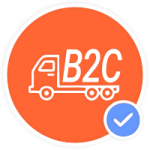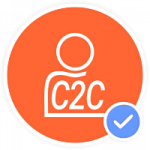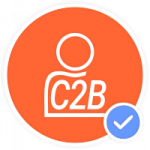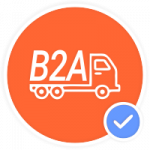Different Types of E-Commerce
Ever since the first online transaction occurred nearly 25 years ago, e-commerce has exploded into one of the most important industries today. In 2018, e-commerce made up 14.3% of U.S. retail sales, up from just over 12% in 2017.
E-commerce has become so commonplace that many people may not even realize when they’re part of an e-commerce transaction.
Because of how broad the term is, e-commerce can be tough to define. But because e-commerce is growing at a rapid pace, understanding what constitutes an e-commerce transaction is crucial for most, if not all, businesses.
According to e-commerce software company Shopify, e-commerce is “the buying and selling of goods or services using the internet.” The definition also requires that a transfer of money and information take place online.
What is lost in this definition is the implication of what is not considered e-commerce. Just because a business exists online doesn’t mean they’re involved in e-commerce.
At the same time, an e-commerce transaction doesn’t require a business at all, just two parties that are completing a transaction online. E-commerce can mean anything from a retail sale to drop shipping.
To better understand e-commerce and its impact, businesses should learn about the different types of e-commerce.
[Related: How to Start an E-Commerce Website]
B2B is one of the most common types of e-commerce. This is when a transaction of goods or services occurs between two businesses.
B2B is one of the largest types of e-commerce in the U.S., with total sales eclipsing $9 trillion in 2018. In fact, B2B is expected to be double the size of B2C by 2020.
A B2B transaction could involve a mining company purchasing equipment from a heavy machinery company, or even a business getting supply chain logistics services.
Perhaps the most common form of e-commerce, B2C occurs when a business sells a good or service to a consumer. For example, Netflix engages in B2C e-commerce when it sells its service to viewers. The entire transaction occurs online.
Goods can be purchased through B2C e-commerce as well. The purchase of a physical good off Amazon is considered a B2C transaction.
In the B2C relationship, consumers often choose goods or services that have low prices, and research shows that consumers value expedient and affordable shipping.
One interesting development in online traffic has been the booming growth of cell phone use. In fact, the majority of internet use occurs on mobile phones. Unsurprisingly, this has correlated with the growth of m-commerce.
M-commerce can look like another type of e-commerce. For example, a B2C purchase that takes place on a mobile device is considered both B2C and m-commerce.
Because it incorporates other types of e-commerce, m-commerce has established itself as an e-commerce leader. In 2017, m-commerce made up 34.5% of all e-commerce. By 2021, m-commerce is expected to make up 53.9% of all e-commerce, and growth should only continue from there.
To keep up with competitors, all e-commerce businesses need to use responsive, mobile-friendly sites and checkouts. As more people go mobile, sites also need to do a better job of targeting mobile users.
With over 3.5 billion users worldwide, the growth of social media has changed e-commerce. The biggest social media site, Facebook, realized that it could keep its users on-site longer by offering a platform to buy and sell goods and services. The result was Facebook-commerce. While F-commerce refers directly to Facebook, the term is often used to describe e-commerce on social media sites as a whole.
Much like m-commerce, F-commerce can consist of other types of e-commerce sales, such as B2B or B2C. A sale that takes place on a mobile device via Facebook would be considered both m-commerce and F-commerce.
F-commerce doesn’t command the same market size as other types of e-commerce, but that could be because it’s a relatively young development. With billions of people checking social media, F-commerce is a space where e-commerce companies are always looking to expand.
[Related: Best E-Commerce Payment Options]
Although businesses don’t have as large of an impact on this type of transaction, customer-to-customer (C2C) transactions are still important. These transactions rely on a third party to act as an intermediary.
As an example, consider eBay. While eBay isn’t selling or purchasing goods, they’re providing a service to their users. Payments are safely done through eBay’s site, and the buyer’s and seller’s information is transferred online. In this C2C relationship, the intermediary doesn’t facilitate shipping, though, as that service is generally provided by the seller.
A lesser-known form of e-commerce, C2B is similar to C2C in that an intermediary is often required. In this transaction, the consumer acts as a seller and the business acts as a buyer.
Stock photos are an excellent example of a C2B transaction. The consumer takes a photo and uploads it to a stock photo site. The business then pays for the right to use the stock photo. The intermediary site hosts the transaction, transferring the money and information online.
B2A e-commerce, also referred to as B2G, is when a business provides an online service for the government, generally through a website.
One way to understand B2A e-commerce is through taxes. Taxes, which go to the government, can be filed online through third-party businesses, such as TurboTax or H&R Block.
Similar to B2A, C2A occurs when a consumer is providing something for the government.
A C2A transaction can be as simple as paying for parking tickets or ordering a new government ID. However, to be considered a C2A e-commerce transaction, this must be done online. While C2A and B2A aren’t the most important e-commerce types today, both are an important part of the future of online transactions.
The quick growth of e-commerce hasn’t just forced businesses to adjust their long-term strategies. Online sales add more steps and variables than in-person sales, the most important of which is shipping.
To meet the shipping demands of their customers, businesses need to focus on their supply chains. Since the application of same-day shipping, traditional supply chains aren’t always efficient enough to keep businesses competitive. Oftentimes, e-commerce businesses can’t afford to maintain their own fleet, own and manage their warehouses, or employ workers at every stage of the shipping process.
While not every e-commerce style depends on the timely shipping of goods, those that do often rely on a successful 3PL partnership to reduce costs and increase efficiency.














